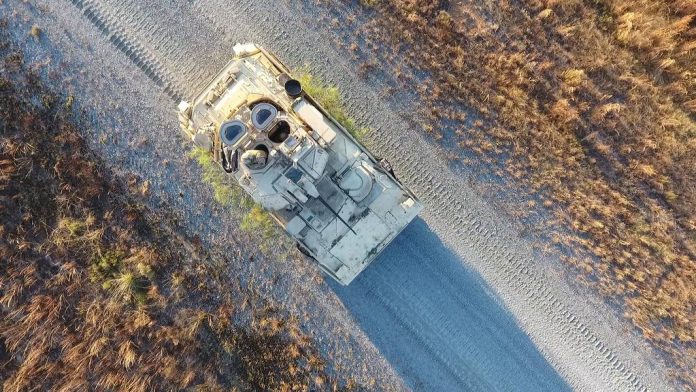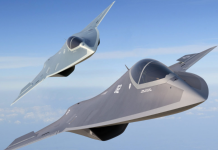The U.S. Army’s replacement of the Bradley infantry fighting vehicle is likely to be the service’s first combat vehicle with hybrid power, Brig. Gen. Glenn Dean, program executive officer for ground combat systems, said at the Eurosatory defense expo in Paris.
The Army’s Optionally Manned Fighting Vehicle competition has already kicked off, with five teams in a preliminary design phase: Point Blank Enterprises, Oshkosh Defense, BAE Systems, General Dynamics Land Systems, and American Rheinmetall Vehicles.
All five developed initial designs that are hybrid, Dean said, a capability the Army considers ever more important as it seeks a smaller, tactical logistics footprint.
The service has observed Russia’s missteps during its invasion of Ukraine over the last several months, particularly its 40-mile-long column of armored vehicles, which stalled for several reasons, including logistics failures in which the military was unable to effectively refuel, resupply, and maintain the convoy.
Reducing dependency on fuel would be an important element of developing a smaller logistics tail, Dean argued.
The Army has spent the last year working with the five teams to develop designs based on characteristics rather than requirements. The service has no requirements for a hybrid electric capability when it comes to OMFV, but it does have the need for a reduced logistics footprint, and it wants a silent watch and silent mobility capabilities to avoid detection on the battlefield, Dean explained.
At Eurosatory this week, Rheinmetall discussed its OMFV offering under development with partners L3Harris Technologies, Textron, Raytheon Technologies and Allison Transmission. The effort includes making a powertrain that supports hybrid fuel technology, according to Matt Warnick, managing director at American Rheinmetall.
“When you look at some of the capabilities that they want to have like silent maneuver and silent watch, the high-power architecture that you have to have for the 50[mm cannon], you have to have the bones in there, so it lends itself to that,” he said of the powertrain.
“I think the batteries have finally caught up to a point right where you can use them in a tactical environment,” Warnick told Defense News. “You can use them safely and comfortably so that technology is all matured. I think that’s the big driving factor. Plus we know the government’s desire, what they want to do, and there’s a tactical advantage to having the ability to have hybrid drive.”
The Army is expected to release two requests for proposals to the industry by the end of the month, asking for detailed designs (the third phase of the competition) and prototypes (the fourth phase).
Requirements to be included in the upcoming RFPs are not “final requirements,” Dean said, as much is still open for industry interpretation to allow for greater flexibility and innovation. For general requirements, he added, “at the highest level” the vehicle will be of mediumweight (roughly between 40 and 50 tons) and will be tracked.
The Army expects to equip it with at least a 30mm cannon, but the objective requirement would be a 50mm gun. The service is also considering other weapons systems such as anti-tank guided missiles and machine guns.
The vehicle would accommodate a two-person crew with six dismounted infantry, Dean added but balanced with a greater application of autonomy on the platform.
The vehicles will be built around a modular, open-systems architecture, which Dean said is a top priority because it allows for rapid upgrades.
The Army plans to award up to three contractor teams through a full and open competition to go into the detailed design phase, which will take place in fiscal 2023 and fiscal 24. Awards for up to three contractors are expected in the second quarter of FY23.
The prototyping phase will begin in FY25, and the Army is expected to select in the fourth quarter of FY27 one company to build low-rate production vehicles. Full-rate production is expected to begin in FY30.
Meanwhile, the Army is expected to make a decision on whether it will consider developing and fielding a hybrid version of the BAE Systems-manufactured Bradley in FY23 following an ongoing assessment of what is possible.
The Bradley vehicle is already pushed to the maximum when it comes to using power to support everything from running the vehicle to controlling its payloads. Going hybrid would provide other benefits as well such as greater survivability by reducing thermal and acoustic signatures, better acceleration, increased lethality, and more onboard power to support the possible incorporation of high-energy lasers, according to budget documents.
The Army’s recently released climate strategy lays out a goal to field fully electric tactical vehicles by 2050, but hybrid ones by 2035.
Going fully electric is a tougher nut to crack.
“It’s about size and weight,” Dean told Defense News a year ago. “If you took the amount of batteries with current technology that you would need to move an Abrams tank purely electrically, it’s bigger than the tank, so we have a packaging and storage problem when it comes to pure electric.”





